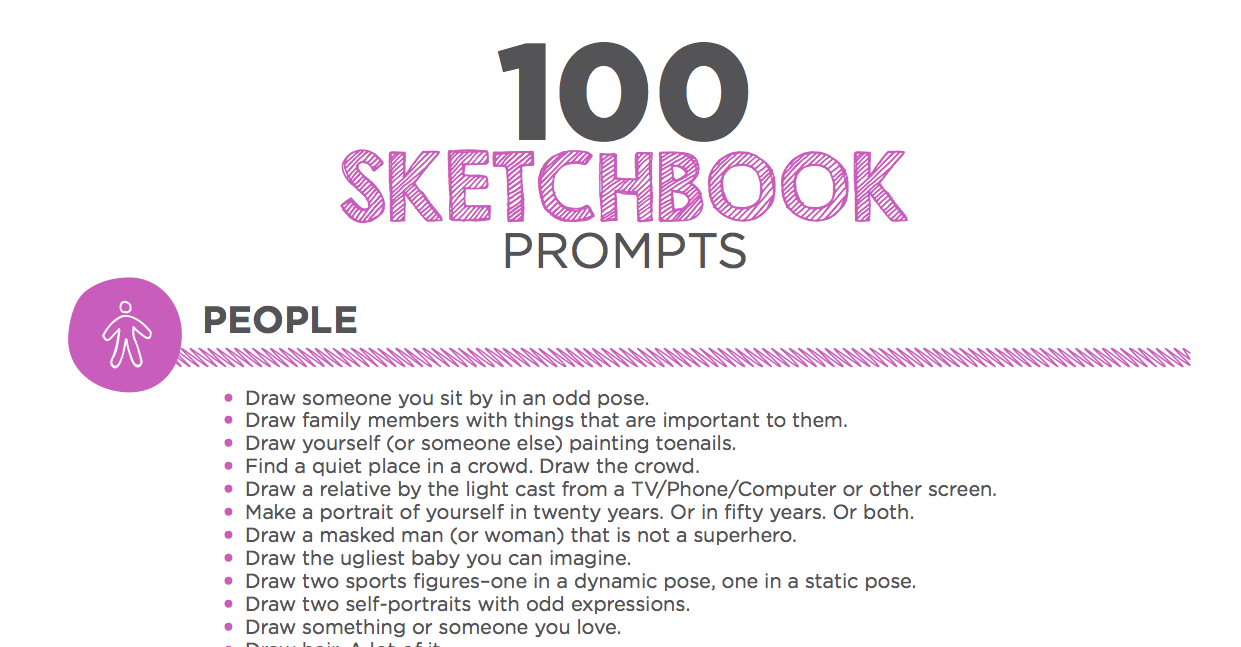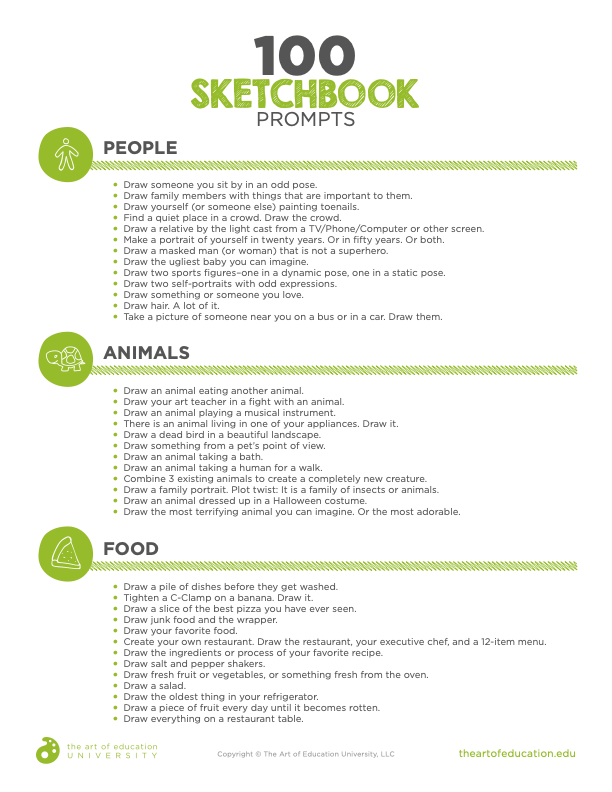If you’re anything like me, you can never get enough good sketchbook ideas. I’m always looking for ways to engage students so that they truly want to work in their sketchbooks. Whether you use sketchbooks for project planning, skill development, brainstorming, or something else, you’ll find ideas here that will work for you. My sketchbook assignments and prompts take an “all of the above” approach, making the following list well-rounded.
Want an eBook with all these prompts? Click 100 Sketchbook Prompts eBook to find it!
The list covers many bases and is organized by category. There are prompts about animals, food, people, and other things that will spark interest among students. This list is geared toward secondary students, but you’ll find a lot here that will work for younger students as well. Take a look and see what will work best for you and your students. Add your own favorite sketchbook assignment in the comments below!
Click here to download the list!
Download Now
These prompts are an amazing place to start. However, knowing how to implement the prompts and manage students with sketchbooks is important, too! If you’d like ideas to help your students develop their creativity, drawings skills, and information retention, be sure to check out the following two PRO Packs, which can be found in our PRO Learning.
- Sketchbook Ideas that Really Work
- Implementing Sketchnotes in the Art Room
100 Sketchbook Prompts Your Students Will Love
People
- Draw someone you sit by in an odd pose.
- Draw family members with things that are important to them.
- Draw yourself (or someone else) painting toenails.
- Find a quiet place in a crowd. Draw the crowd.
- Draw a relative by the light cast from a TV/Phone/Computer or other screen.
- Make a portrait of yourself in twenty years. Or in fifty years. Or both.
- Draw a masked man (or woman) that is not a superhero.
- Draw the ugliest baby you can imagine.
- Draw two sports figures–one in a dynamic pose, one in a static pose.
- Draw two self-portraits with odd expressions.
- Draw something or someone you love.
- Draw hair. A lot of it.
- Take a picture of someone near you on a bus or in a car. Draw them.
Animals
- Draw an animal eating another animal.
- Draw your art teacher in a fight with an animal.
- Draw an animal playing a musical instrument.
- There is an animal living in one of your appliances. Draw it.
- Draw a dead bird in a beautiful landscape.
- Draw something from a pet’s point of view.
- Draw an animal taking a bath.
- Draw an animal taking a human for a walk.
- Combine 3 existing animals to create a completely new creature.
- Draw a family portrait. Plot twist: It is a family of insects or animals.
- Draw an animal playing a musical instrument.
- Draw the most terrifying animal you can imagine. Or the most adorable.
Food
- Draw a pile of dishes before they get washed.
- Tighten a C-Clamp on a banana. Draw it.
- Draw a slice of the best pizza you have ever seen.
- Draw junk food and the wrapper.
- Draw your favorite food.
- Create your own restaurant. Draw the restaurant, your executive chef, and a 12-item menu.
- Draw the ingredients or process of your favorite recipe.
- Draw salt and pepper shakers.
- Draw fresh fruit or vegetables, or something fresh from the oven.
- Draw a salad.
- Draw the oldest thing in your refrigerator.
- Draw a piece of fruit every day until it becomes rotten.
- Draw everything on a restaurant table.
Objects
- Draw what is in the rearview mirror of the car.
- Draw moving water. Draw still water.
- Draw an object floating.
- Make a drawing of all of your drawing materials.
- Find a trash can. Draw its contents.
- Draw tools that belong to a certain profession.
- Draw three objects and their environments. One of the three should be in motion.
- Draw the interior of a mechanical object. Zoom in, focus on details and shading.
- Create three drawings of messes you have made.
- Draw five objects with interesting textures: wood grain, floors, tiles, walls, fabric, etc.
- Draw a collection of purses, wallets, or bags.
- Draw your favorite well-loved object or childhood toy.
- Draw a watch or another piece of jewelry.
- Draw something hideous that you keep for sentimental reasons.
- Draw something with a mirror image.
Technical Skill/Skill Development
- Draw all the contents of your junk drawer with one continuous line.
- Make a detailed drawing of a rock.
- Draw a dark object in a light environment.
- Draw a light object in a dark environment.
- Make a detailed drawing of five square inches of grass.
- Draw a transparent object.
- Draw a translucent object.
- Do several studies of eyes, noses, and mouths in a variety of poses.
- Draw an interesting object from three different angles.
- Value Studies–Draw three eggs and part of the carton with a strong light source.
- Draw three metallic objects that reflect light. Focus on highlights and reflections.
- Refraction–Create two drawings of separate objects partially submerged in water.
- Make three drawings (your choice of subject) using materials with which you are not familiar.
- Draw a piece of patterned fabric with folds.
- Draw a bridge and all of its details.
Creativity/Originality
- Draw yourself as an original superhero.
- Make a drawing that looks sticky.
- Draw a mysterious doorway or staircase.
- Draw an empty room. Make it interesting.
- Draw a flower. Make it dangerous.
- Draw an object melting.
- Draw an imaginary place, adding all kinds of details.
- Draw a gumball machine that dispenses anything but gumballs.
- Danger! Draw yourself in a dangerous situation.
- You are on the back of the bus. Figure out who is with you, where you are going, and why. Illustrate and explain.
- Draw what’s under your bed (real or imagined).
- Draw the most incredible game of hide-and-seek you can imagine.
- Create a new sport. You can improve an existing sport, combine two existing sports, or come up with something completely new.
Open-Ended Themes
- Make a drawing that is totally truthful.
- Make a drawing that lies all over the place.
- Make a drawing that is completely and utterly impossible.
- Story Illustration: Fix a story that you don’t like, or reflect/improve upon one you do.
- Let someone else choose your subject and tell you what to draw.
- Draw your greatest fear.
- Use song lyrics, quotes, or poetry to inspire a drawing.
- Find the three most useless objects you can and draw them.
- Draw an interesting form of transportation.
- Draw something for which you are thankful.
- Go somewhere new and draw what you see.
- Draw something that can’t be turned off.
- Draw something soothing.
- Draw something you think sounds or smells incredible.
- Draw something that needs fixing.
- Draw something you’ve always wanted.
- Draw something out of place.
- Draw something that should have been invented by now.
- Draw something you keep putting off, or something that causes you to procrastinate.
Does this list inspire you to take some sketchbook assignments head on in your art room? Or maybe the opposite is true and you are finding that you feel underprepared to teach drawing skills. Maybe you fall somewhere in between and you just need a little more inspiration to tweak your drawing curriculum. These are all great reasons to take a peek at our course, Studio: Drawing. The class is jam-packed with hands-on learning experiences, advanced technique tutorials, and opportunities to share and learn with art teachers just like you.
What are your favorite sketchbook prompts to use?
How do you use sketchbooks in your classroom?
Magazine articles and podcasts are opinions of professional education contributors and do not necessarily represent the position of the Art of Education University (AOEU) or its academic offerings. Contributors use terms in the way they are most often talked about in the scope of their educational experiences.






